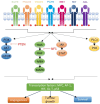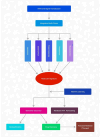Current Research Trends in Glioblastoma: Focus on Receptor Tyrosine Kinases
- PMID: 40332008
- PMCID: PMC12027435
- DOI: 10.3390/ijms26083503
Current Research Trends in Glioblastoma: Focus on Receptor Tyrosine Kinases
Abstract
Glioblastoma (GBM) is an aggressive brain tumor characterized by molecular complexity and resistance to conventional treatments, including surgery, radiation, and chemotherapy. Despite these challenges, advancements in receptor tyrosine kinase (RTK) research, combined with multi-omics approaches, hold promise for improving patient outcomes and survivability. RTKs are central to GBM progression, influencing cell proliferation, survival, and angiogenesis. However, the complexity of RTK signaling necessitates a broader, integrative perspective, which has been enabled by the emergence of -omics sciences. Multi-omics technologies-including genomics, transcriptomics, proteomics, and metabolomics-offer unprecedented insights into the molecular landscape of GBM and its RTK-driven pathways. Genomic studies have revealed mutations and amplifications in RTK-related genes, while transcriptomics has uncovered alterations in gene expression patterns, providing a clearer picture of how these aberrations drive tumor behavior. Proteomics has further delineated changes in protein expression and post-translational modifications linked to RTK signaling, highlighting novel therapeutic targets. Metabolomics complements these findings by identifying RTK-associated metabolic reprogramming, such as shifts in glycolysis and lipid metabolism, which sustain tumor growth and therapy resistance. The integration of these multi-omics layers enables a comprehensive understanding of RTK biology in GBM. For example, studies have linked metabolic alterations with RTK activity, offering new biomarkers for tumor classification and therapeutic targeting. Additionally, single-cell transcriptomics has unveiled intratumoral heterogeneity, a critical factor in therapy resistance. This article highlights the transformative potential of multi-omics in unraveling the complexity of RTK signaling in GBM. By combining these approaches, researchers are paving the way for precision medicine strategies that may significantly enhance diagnostic accuracy and treatment efficacy, providing new hope for patients facing this devastating disease.
Keywords: -omics sciences; glioblastoma; molecular diagnostics; receptor tyrosine kinases.
Conflict of interest statement
The authors declare no conflicts of interest.
Figures
Similar articles
-
Regulation of the Receptor Tyrosine Kinase AXL in Response to Therapy and Its Role in Therapy Resistance in Glioblastoma.Int J Mol Sci. 2022 Jan 17;23(2):982. doi: 10.3390/ijms23020982. Int J Mol Sci. 2022. PMID: 35055167 Free PMC article.
-
Multi-Omics Data Integration and Mapping of Altered Kinases to Pathways Reveal Gonadotropin Hormone Signaling in Glioblastoma.OMICS. 2016 Dec;20(12):736-746. doi: 10.1089/omi.2016.0142. OMICS. 2016. PMID: 27930095
-
It's all downstream from here: RTK/Raf/MEK/ERK pathway resistance mechanisms in glioblastoma.J Neurooncol. 2025 Apr;172(2):327-345. doi: 10.1007/s11060-024-04930-w. Epub 2025 Jan 16. J Neurooncol. 2025. PMID: 39821893 Free PMC article. Review.
-
Receptor Tyrosine Kinase Signaling and Targeting in Glioblastoma Multiforme.Int J Mol Sci. 2021 Feb 12;22(4):1831. doi: 10.3390/ijms22041831. Int J Mol Sci. 2021. PMID: 33673213 Free PMC article. Review.
-
Inhibiting receptor tyrosine kinase AXL with small molecule inhibitor BMS-777607 reduces glioblastoma growth, migration, and invasion in vitro and in vivo.Oncotarget. 2016 Mar 1;7(9):9876-89. doi: 10.18632/oncotarget.7130. Oncotarget. 2016. PMID: 26848524 Free PMC article.
References
-
- Sevastre A.-S., Costachi A., Tataranu L.G., Brandusa C., Artene S.A., Stovicek O., Alexandru O., Danoiu S., Sfredel V., Dricu A. Glioblastoma pharmacotherapy: A multifaceted perspective of conventional and emerging treatments. Exp. Ther. Med. 2021;22:1408. doi: 10.3892/etm.2021.10844. - DOI - PMC - PubMed
-
- Koukourakis G.V., Kouloulias V., Zacharias G., Papadimitriou C., Pantelakos P., Maravelis G., Fotineas A., Beli I., Chaldeopoulos D., Kouvaris J. Temozolomide with radiation therapy in high grade brain gliomas: Pharmaceuticals considerations and efficacy; a review article. Molecules. 2009;14:1561–1577. doi: 10.3390/molecules14041561. - DOI - PMC - PubMed
Publication types
MeSH terms
Substances
Grants and funding
LinkOut - more resources
Full Text Sources
Medical




